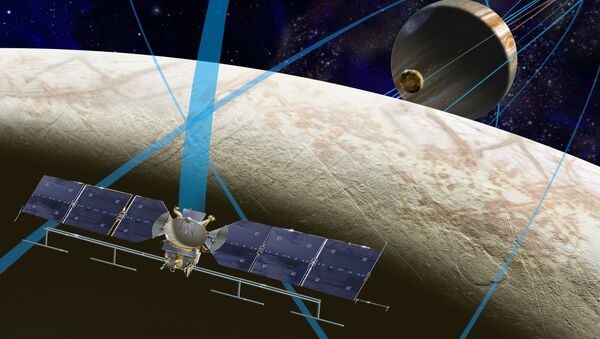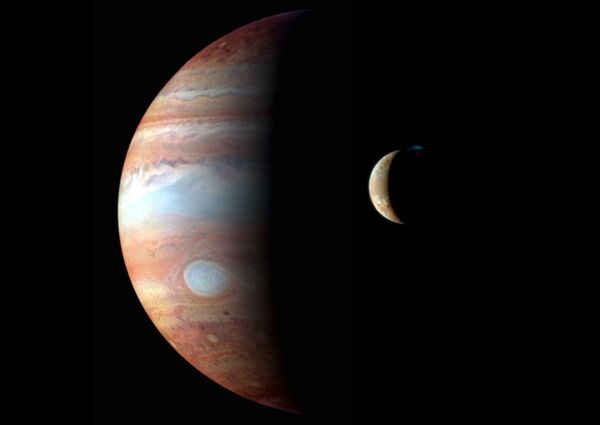Mankind may be on the verge of receiving confirmation that alien life is out there, and we are, by far, not alone in the Universe.
This dramatic forecast is being made ahead of two probes being sent to a mysterious moon near Earth.
Europa is the smallest of Jupiter's four largest moons, but it is one of the more intriguing ones, as its surface is frozen, completely covered with a thick layer of ice. Scientists suggest there is a vast ocean beneath the surface.
The incredibly smooth icy surface also makes the moon one of the most reflective in the solar system.
“Discovery now seems inevitable and possibly imminent,” University of Melbourne researcher Cathal O’COnnell was quoted as saying by The Conversation.
“It seems inevitable other life is out there, especially considering that life appeared on Earth so soon after the planet was formed... And the definition of "habitable" has proven to be a rather flexible concept too," said O’Connell.
In August, NASA confirmed it would build a space probe – the Europa Clipper – to investigate Europa. It followed the announcement in April by the European Space Agency that it would put the Jupiter Icy Moons Explorer (JUICE) in place by 2029.
Europa Clipper's Mission to Jupiter’s Ice Moon Confirmed
Scientists believe that mankind is on the cusp of exploring possibly the best place in our solar system to look for signs of alien life, as they suggest that Jupiter’s ice-covered moon, Europa, contains a salty global ocean.
To determine if the conditions on Europa are, indeed, favourable for life, NASA’s Europa Clipper mission is preparing to conduct its first detailed study of the potentially habitable orb.
NASA's spacecraft, in orbit around Jupiter, will make about 45 close passes over Europa, shifting its flight path for each flyby to move over a different location so that it eventually scans nearly the entire moon.
After each flyby, the spacecraft will send data back to Earth.
The spacecraft is being sent to try to answer specific questions about Europa’s ocean, ice shell, composition and geology.
“We are all excited about the decision that moves the Europa Clipper mission one key step closer to unlocking the mysteries of this ocean world,” said Thomas Zurbuchen, associate administrator for the Science Mission Directorate at NASA Headquarters in Washington.
“We are building upon the scientific insights received from the flagship Galileo and Cassini spacecraft and working to advance our understanding of our cosmic origin, and even life elsewhere.”
NASA is targeting to have the Europa Clipper spacecraft complete and ready for launch as early as 2023.
NASA's Jet Propulsion Laboratory in Pasadena, California leads the development of the Europa Clipper mission in partnership with the Johns Hopkins University Applied Physics Laboratory for the Science Mission Directorate.
Mystery Moon
Europa, the smallest of the four Galilean moons orbiting Jupiter, was discovered in 1610 by Galileo Galilei and named after the Phoenician mother of King Minos of Crete and lover of Zeus (the Greek equivalent of the Roman god Jupiter).
Slightly smaller than Earth's Moon, Europa is primarily made of silicate rock and has a water-ice crust, with a very thin atmosphere, composed primarily of oxygen.
In addition to Earth-bound telescope observations, Europa has been examined by a succession of space-probe flybys, the first occurring in the early 1970s.
The mysterious moon has the smoothest surface of any known solid object in the Solar System, resulting in the hypothesis that a water ocean exists beneath it, which could conceivably harbour alien life. Scientists have theorised that the icy crust is anywhere from 20 to 50 kilometres (12 to 30 miles) thick, and that the subsurface ocean is as much as 100 km (60 miles) deep, meaning the moon would have from 2-3 times as much water as the Earth's oceans. Life on Europa's surface would be far more daunting, with temperatures at the equator peaking at a high of -50 C and radiation levels averaging 5.4 Sv (540 rem) of radiation per day, which is approximately 1,800 times the average annual dose we experience at sea level.
In addition, the Hubble Space Telescope detected water vapour plumes on Europa, similar to those observed on Saturn's moon Enceladus.

In May 2018, astronomers provided evidence of water plume activity on Europa, after updated analysis of data obtained from the Galileo space probe, which orbited Jupiter from 1995 to 2003.
The Galileo mission, launched in 1989, provides the bulk of current data on Europa, as no spacecraft has yet landed on Europa.





